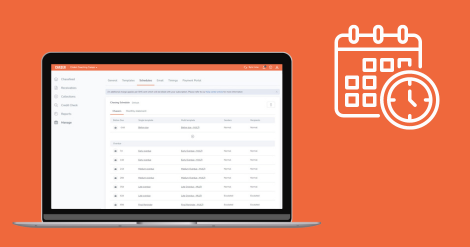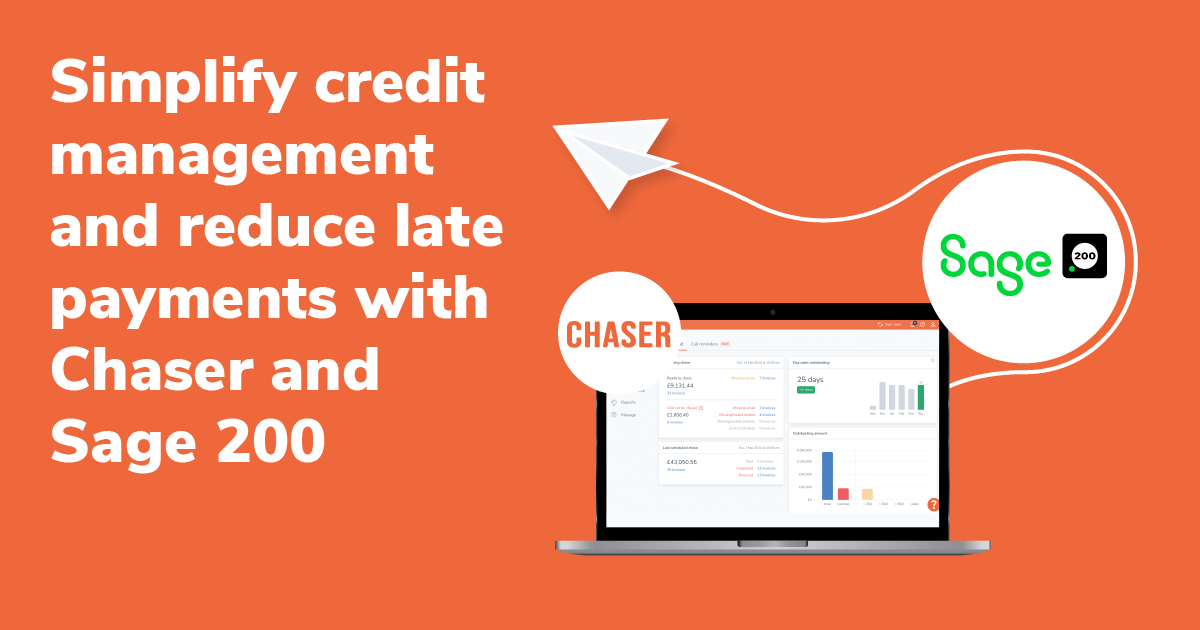Keeping cash flow healthy is crucial for any business, and Chaser offers a powerful tool to help automate and optimise your debt collection process. With customisable schedules, you can ensure timely payments while maintaining positive customer relationships. Let's explore the best strategies for setting up chasing schedules and some tailored options to fit various industries and credit control styles.
Why chasing schedules matter
Chasing schedules are the backbone of an effective credit control process. They determine when and how you communicate with debtors, strategically timing reminders and notices to maximise the chances of getting paid. By customising these schedules, you can balance the need for timely payments with maintaining a good relationship with your customers.
Chasing schedule options
Here are three different approaches to schedules, each using a mix of methods to ensure you get paid on time while keeping your customers happy.
Option 1: The balanced approach
This schedule balances persistence and maintaining customer relationships, making it suitable for most industries. It ensures regular communication without overwhelming the debtor, gradually increasing the urgency of the messages.
Pre-due date reminders:
- 14 days before the due date: Email reminder
- Purpose: A gentle nudge to remind the debtor about the upcoming due date, giving them ample time to prepare.
- 7 days before the due date: SMS reminder
- Purpose: An immediate, attention-grabbing reminder of the approaching deadline.
Overdue reminders:
- 1 day overdue: Email notice
- Purpose: A polite reminder that the payment has been missed, encouraging prompt action.
- 7 days overdue: Call reminder task
- Purpose: A personal call to address any issues directly, adding a persuasive touch.
- 10 days overdue: SMS reminder
- Purpose: An immediate, attention-grabbing reminder related to the overdue debt.
- 14 days overdue: Auto-call
- Purpose: An automated call to emphasise the overdue status, increasing the chances of reaching the debtor.
- 21 days overdue: Email notice
- Purpose: A reminder to maintain pressure and reiterate the need for immediate payment.
- 30 days overdue: Paper letter
- Purpose: A formal letter signifying the seriousness of the overdue account, often prompting action due to its official nature.
This approach uses a mix of reminders and escalating methods to ensure visibility and urgency at different stages. Early reminders aim to prompt payment before the due date. At the same time, the progression from emails and SMS to auto-calls and paper letters post-due ensures increasing urgency and formal communication, encouraging prompt payment while maintaining customer relations.
Option 2: The persistent approach
This schedule is designed for industries with higher risks of non-payment or shorter payment terms, such as retail and e-commerce;. It focuses on frequent and varied communication to keep the debtor constantly aware of the overdue status.
Pre-due date reminders:
- 10 days before the due date: SMS reminder
- Purpose: A quick, direct reminder for shorter payment cycles.
- 5 days before the due date: Email reminder
- Purpose: Reinforces the upcoming due date, ensuring it stays top-of-mind.
Overdue Reminders:
- 1 day overdue: SMS notice
- Purpose: Immediate communication following the missed due date for a quick resolution.
- 3 days overdue: Email notice
- Purpose: Adds formality and provides detailed information about the overdue status.
- 7 days overdue: Auto-call
- Purpose: An auditory reminder to increase pressure.
- 10 days overdue: Second SMS notice
- Purpose: Another SMS ensures the debtor cannot ignore the overdue payment.
- 14 days overdue: Call reminder task
- Purpose: A personal call to address any issues and discuss payment arrangements.
- 21 days overdue: Email notice
- Purpose: Continued email communication to maintain pressure.
- 28 days overdue: Paper letter
- Purpose: A formal letter as a final warning before considering more severe actions.
This persistent schedule ensures the debtor is continually reminded of the overdue payment. Early intervention through SMS and emails, followed by auto-calls and paper letters, aims to prompt quicker action, which is critical in high turnover industries.
Option 3: The gentle approach
Ideal for professional services and industries where maintaining a positive client relationship is crucial, this schedule is less frequent and more spaced out. It focuses on maintaining a friendly and professional tone.
Pre-due date reminders:
- 14 days before the due date: Email reminder
- Purpose: Helps clients plan for the upcoming payment without feeling pressured.
- 7 days before the due date: Email reminder
- Purpose: A second gentle reminder to ensure the due date isn't forgotten.
Overdue Reminders:
- 3 days overdue: Friendly email notice
- Purpose: Acknowledges the overdue status without being confrontational.
- 7 days overdue: Call reminder task
- Purpose: Allows for a direct conversation to understand any issues and encourage payment.
- 14 days overdue: Second email notice
- Purpose: Another reminder to maintain awareness of the overdue payment.
- 21 days overdue: Friendly auto-call
- Purpose: An automated call that remains friendly and professional.
- 28 days overdue: Paper letter
- Purpose: A formal letter signifying increasing seriousness, prompting action without damaging the relationship.
This schedule prioritises maintaining a positive client relationship while ensuring timely payments. The reminders are spaced out, and the tone remains friendly, suitable for industries where long-term relationships and client satisfaction are crucial. The progression to more formal methods is gradual, allowing ample opportunity for clients to respond positively.
Set up schedules in Chaser
To set up effective chasing schedules in Chaser, follow these steps:
- Identify needs: Assess industry standards and typical client interactions to understand the most effective communication methods and frequencies.
- Set up default schedules: Use the outlined chasing schedules as a starting point. Chaser allows for easy adjustments to these templates.
- Customise per scenario: Adjust the frequency, method, and tone of communications based on specific needs, such as average payment terms, the importance of the client relationship, and typical debtor behaviour.
- Monitor and adjust: Regularly review the effectiveness of schedules by analysing payment patterns and debtor responses. Adjust schedules as needed to improve collection rates and maintain healthy cash flow.
Industry standards and best practices
Understanding industry standards and best practices can help tailor chasing schedules to be more effective. Each industry has unique characteristics that influence the optimal approach to debt collection.
Professional services (consulting, legal, etc.)
- Best practices:
- Maintain a balance between persistence and relationship management.
- Use friendly, professional communication methods.
- Pre-due reminders and gentle overdue chases help maintain goodwill.
- Standards:
- Regular email reminders maintain a professional tone.
- Personalised phone calls for overdue accounts can resolve issues quickly.
- Limited use of formal letters to avoid damaging client relationships.
Retail and e-commerce
- Best practices:
- Implement frequent reminders due to shorter payment terms.
- Utilise automated methods for efficiency.
- Ensure communication is clear and concise.
- Standards:
- Frequent SMS and email reminders keep debtors informed and prompt timely payments.
- Automated calls for overdue accounts ensure consistency and coverage.
- As a last resort, formal letters convey seriousness without overwhelming the debtor early on.
Manufacturing and wholesale
- Best practices:
- Use structured and formal communication methods.
- Pre-due reminders to avoid large overdue amounts.
- Escalate quickly for significant overdue amounts to manage cash flow.
- Standards:
- Formal emails and letters establish the seriousness of overdue payments.
- Personalised phone calls for overdue accounts can clarify payment terms and resolve disputes.
- Using collection agencies for large debts ensures the professional handling of complex cases.
Additional schedules for your organisation
To manage various debtor scenarios efficiently, consider setting up additional schedules:
- Direct Debit/Monthly Statements: Include only debtors that will receive a monthly statement, helping keep customers informed of their balances and upcoming payments without aggressive chasing.
- Do Not Chase/Hold, Query/Dispute, Bad Debts/Write-Offs, or Debt Collection: Use these schedules as containers for categorising debtors, allowing the credit control team to focus on active accounts while keeping track of those requiring special handling.
Additional insights to optimise your schedules
A few additional strategies can make a significant difference when fine-tuning your debt collection process. Here are some insights to help you get the most out of your chasing schedules:
Customer segmentation
Segmenting customers based on their payment history—such as prompt payers, late payers, and chronic defaulters—can lead to more personalised and effective schedules.
Example: Tailoring the frequency and method of communication according to the debtor's past payment behaviour can increase the chances of timely payments. For instance, chronic late payers might benefit from frequent reminders, while prompt payers might appreciate fewer, more courteous reminders.
Impact of cultural differences
Cultural differences can significantly impact payment behaviours. Adjusting your chasing schedules to accommodate these differences can improve your collection success.
Example: In some cultures, formal communication methods, such as official letters or structured emails, might be more effective. In other cultures, a friendly and informal reminder might be all that's needed. Understanding these nuances can help you choose the right approach for each debtor.
Integrating payment options
Providing multiple payment options in your reminders can make it easier for debtors to settle their accounts promptly.
Example: Include links to the online payment portal, bank transfer details, or other convenient payment methods in your email, SMS and letter reminders. This convenience can encourage quicker payments by making the process easy for your debtors.
Protect your revenue by mastering schedules in Chaser
You can optimise credit control processes, improve cash flow, and maintain strong customer relationships by tailoring chasing schedules to fit your organisation's needs. Custom schedules ensure timely, appropriate, and effective communication, aligning with industry standards and best practices.
Speak to an expert about how mastering schedules can help you protect your revenue, or see it for yourself with a 10-day free trial.




